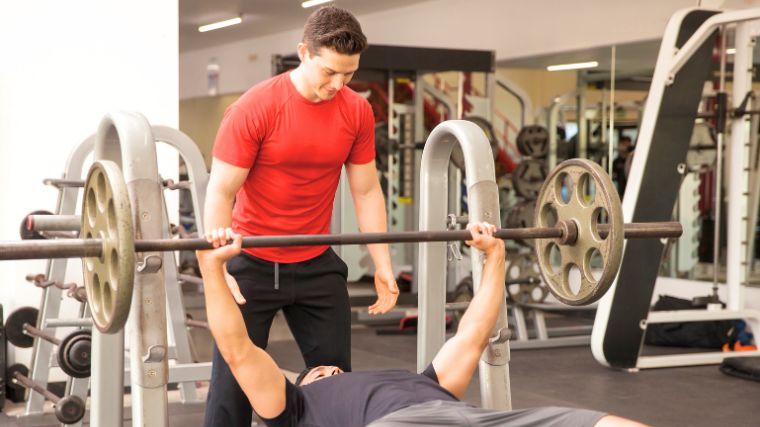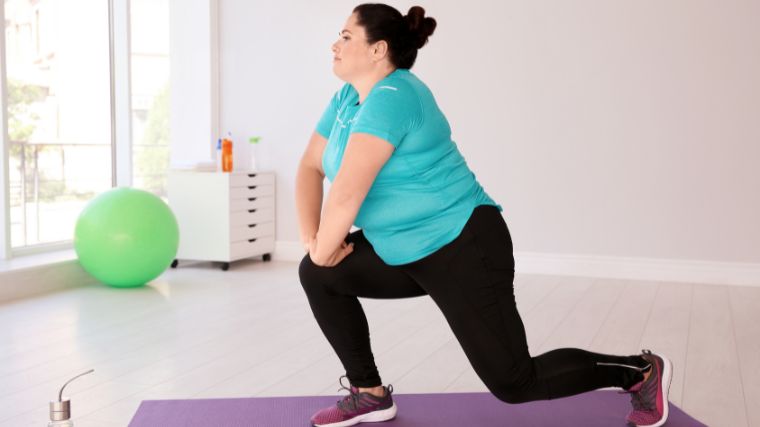For building muscle, strength, or any goal you can think of, repetitions will drive your results. Breaking down every single rep you do into its specific components — that is, a concentric and an eccentric phase — can help you stop mindlessly churning out reps and instead, maximize everything you’re doing in the gym.
The concentric portion of a lift is when you are producing force and the muscle is shortening, like the upward part of a biceps curl. The eccentric phase is when you are producing force but the muscle is lengthening, like when you control the downward part of a biceps curl.

For most exercises, each rep contains both a concentric and eccentric phase. However, you can also design entire training routines around either concentric or eccentric training. Here’s the down and dirty about concentric versus eccentric training, including which phase will get you to your goals faster.
What Is Concentric Training?
Any strength training program will prescribe any number of different training variables for you to manipulate. How much weight you lift and for how many reps, how long you rest between sets, and how often you train is all essential information for a good program.
Manipulating these variables to consistently apply progressive overload is the core tenet of making gains. But they’re not the only variables at play. Organizing your workouts around a predominately concentric or eccentric style of training can impact your results.

[Read More: The Best Foods for Energy Before, During, and After Your Workouts]
Concentric training refers to the part of the movement where your muscles are contracting (rather than lengthening). Think about actively curling a barbell or standing up out of a squat.
This type of training requires you to be able to lift the weight you’re attempting to pull or push. On the other hand, muscles tend to be stronger eccentrically than concentrically. This means that you can lift more on the eccentric than the concentric. In that way, your training is generally limited by your concentric strength.
Concentric Exercises
Generally speaking, exercises naturally come with both a concentric and eccentric component. A pull-up, for example, contains a concentric pulling phase where you put your chin over the bar. Then, it has its eccentric component where you lower yourself under control to an arms-extended position.
But there are exercises that you can perform that only feature concentric movements. Here are a few:
- Bar-Drop Barbell Deadlift*
- Bar-Drop Barbell Row*
- Sled Push
* Perform the concentric (pulling) portion of the lift. When you reach lockout, drop the bar to eliminate the eccentric component. Use bumper plates to ensure the safety of both yourself and your equipment.
What Is Eccentric Training?
In most exercises, the eccentric component of a lift is the lowering phase. When you sink into a squat, control your descent from a pull-up or biceps curl, or lower the barbell to the platform, you’re doing the eccentric portion of an exercise.
It can be helpful to think of eccentric repetitions as resisting the weight as opposed to lifting the weight. Eccentric training specifically overloads the lowering phase of each repetition. Typically, you can successfully move through this lowering phase with a greater load than you’re capable of lifting on the concentric.
Eccentric Exercises
To emphasize the eccentric, you’ll often need a spotter or other form of assistance to get you back to the starting position. For an eccentric pull-up — often referred to as a negative — you’ll perform a jumping pull-up to get yourself back above the bar without spending much concentric energy.

In the case of eccentric bench presses, for example, make sure you have a very reliable, experienced spotter to help you get the bar off your chest and back up to lockout. With all of these exercises, try to extend the eccentric phase for anywhere between three and 10 seconds.
- Eccentric Pull-Up
- Eccentric Push-Up*
- Eccentric Lunge or Split Squat
- Biceps Curl Negative**
* Press back into push-up position by supporting yourself with your knees. No need to perform full push-ups (concentric contractions) between reps unless you want an extra challenge.
** Especially if you’re opting to lift heavier than you could with concentric contractions, have a training partner help you bring the weight up to starting position. Resist the lowering of the weight as much as you can on your own.
When to Do Concentric Vs. Eccentric Training
If you’re training “normally,” you’ll naturally find both concentric and eccentric movements in your program in relatively equal measure. But depending on your fitness goals, concentric and eccentric-dominant training can take your gains to the next level.
For Strength
Strength training helps improve the maximum amount of weight that you can lift with any given exercise. Still, strength training is also highly skill dependent. The quality of your technique impacts the success of your lift.
While you are technically stronger in the eccentric phase of a muscle contraction, emphasizing eccentric training for absolute strength might not be the best idea. (1) Managing loads that you can concentrically perform will have the most specific carryover for skilled execution in competition.
Don’t neglect the concentric aspect of training to make sure you’re only managing loads you can safely lift. For these reasons, concentric training is recommended here.
For Muscle Growth
Both concentric and eccentric muscle training have been shown to produce muscle growth. But eccentric training may actually be slightly more effective than concentric training at building muscle. (2)
But before you start to completely remodel your entire training program around eccentric training, there are some logistical considerations. Eccentric training might require special set-ups or spotters to properly execute, and may also be harder to track long term.

[Read More: Nutrition for Athletes — How to Eat for Muscle and Performance]
Given how close they are to each other in overall outcomes, either choice is good. You can choose either concentric or eccentric training for muscle growth with a high level of confidence that you can gain muscle mass.
As a Beginner
As a beginner, you may want to harness your eccentric strength to help with foundational growth. Controlling the eccentric component of your exercises will teach you to use excellent form and focus on building a mind-muscle connection from the very start of your training journey.
Developing a well-balanced physique and strength base will ultimately draw upon both styles of training, so make sure you’re using both as a beginner. But starting with eccentric training as a launchpad — at least as something you pay special attention to with each rep — can help.
On the other hand, the eccentric portion of training can leave lifters much sorer than concentric lifts. (3) That may be extremely uncomfortable for beginners and may even discourage them from continuing. In that sense, sticking to concentric-focused training may therefore be a better bet.
Intensifiers
An intensifier does exactly what it sounds like — it’s a way to make an exercise more intense to take your muscles (and mental fortitude) to the limit.
Types of training intensifiers span the gamut from drop sets and manipulating rest times to 1 ½ reps and forced repetitions. If you’re aiming to increase the challenge of a given workout or exercise, eccentrically overloading a lift by eliminating the concentric phase is a popular and very effective means of upping the ante of your workout.
Use this technique sparingly, in short training blocks with plenty of recovery in between training bouts. You’ll also want to make sure you have a reliable spotter to ensure your safety during many of these movements.
Benefits of Concentric Repetitions
Concentric training typically will produce less soreness, is easier to progress, and is ultimately simpler to perform in many cases.
Less Soreness
Eccentric contractions are commonly associated with muscle damage and delayed onset muscle soreness (DOMS). (3) On the other hand, concentric training can help mitigate the muscle damage effect from eccentrics by simply de-emphasizing them.
[Read More: Best Post-Workout Supplements]
To reduce soreness from eccentrics, control your weights, but don’t overload or spend an exorbitant amount of time lingering in the eccentric.
Easier to Progress
Progressive overload requires the meticulous tracking and manipulation of training variables to help your muscles experience a similar or greater challenge each workout. Concentric training helps give you the best shot at accurate tracking since there are less variables to worry about.
During eccentric training, the degree to which your spotter may assist, how many repetitions beyond failure you go, the precise number of seconds you spend lowering the bar, or how much control you really have during each repetition can be hard to quantify. Concentric training allows a much more clear-cut method of tracking your daily progress.
Easier to Perform
Concentric workouts are scaled to what your muscles can overcome all on their own. Unless you’re planning to go to failure, you generally select a load that you can successfully lift without assistance.
This means that technique may be easier to maintain and you won’t need as much psychological hype to get going.
Benefits of Eccentric Repetitions
You can typically load eccentric repetitions heavier than their concentric counterparts. This type of training can also help you break through strength training plateaus and create shorter workouts.
More Loading Potential
Generally speaking, lifters are stronger in the eccentric phase than in the concentric phase of a lift. That’s because research suggests that your muscles are often better at resisting weight (eccentric) than lifting it (concentric). (4)

[Read More: The 8 Best Knee Sleeves You Can Buy (Spring 2023 Update)]
While you don’t have to (and shouldn’t) make every set and repetitions a one-rep max, having the option to train heavier is an asset. The heavier you can go, the fewer repetitions you’ll need to spur improvements. This is fantastic for helping manage “junk volume” (aka, repetitions that don’t contribute much to your progress) and skip right to the harder stuff.
Breaking Plateaus
Eccentric training, particularly eccentric overload training with a partner, can be a great way to bust through plateaus. Exposing your muscles to a blast of heavier-than-normal load (while under control and with a spotter) can help train your coordination and confidence, and pack a huge punch.
Since you are stronger and may be able to grow more muscle with the eccentric, consider shaking up a plateau with a short eccentric training block.
Shorter Workouts
Since eccentric training tends to be heavier and forces you to focus, you can likely shorten your workouts. Getting each set closer to failure using higher loads during eccentric training can help cut the middle-man out of each workout.
With concentric training, you may require pre-exhaust sets or higher volumes to approach failure. By slowing down your lifts, eccentric training speeds right past that. Get in, hit the muscle hard, and leave for some well-earned recovery.
Concentric Vs. Eccentric Repetition Technique
Concentric and eccentric training can be pretty unique in their training requirements, set-up, and execution. These are some important differences for you to consider.
What You Need
Though there are both concentric and eccentric phases to most individual lifts, you may need slightly different things if you’re entering a concentric-only or eccentric-only training block.
Concentric Repetitions
Concentric repetitions are fairly straightforward. They can be performed solo without the help of a training partner or a spotter. Simply grab the weight, line up the cables, or lie back on a weight bench, and you’re good to go.

[Read More: The 8 Best Lifting Straps You Can Buy (Spring 2023 Update)]
However, when you’re focusing only on the concentric portion of a lift, set yourself up to safely drop the weight between each rep. Generally, this involves a barbell, bumper plates, and reliable, crash-safe gym flooring.
Eccentric Repetitions
Eccentric-only training is a bit more involved. Your goal is to choose a weight that you cannot necessarily lift on your own during the concentric, but can still handle on the eccentric.
Because of this, true eccentric overload training often requires a training partner or experienced spotter. If your intent is to choose a weight that you can only lift for the eccentric, someone will need to be around to help you on each concentric portion.
Setting Up
You’re in the gym, you have your plan… now what? Here’s what to do with your equipment and program once you’ve got it.
Concentric Repetitions
Concentric repetitions are extremely straightforward. Once you’ve selected the exercise, all you need to do is get after it. Special consideration can be made to help find stability points. For example, a single-arm dumbbell row can be improved by finding the right bench or dumbbell rack to brace against.
Overall, it’s pretty simple to line up your exercise angle and go to town. Even in movements such as a heavy dumbbell shoulder press, most weights are manageable on your own. In this case, simply kicking the dumbbells into position with your thighs is normally more than enough to get you going.
Eccentric Repetitions
On the other hand, eccentric repetitions can be a bit more of a task to set up. Eccentric training is most effective when you’re targeting loading ranges that you can’t lift concentrically on your own. This will inherently require either a spotter, safety bars, or any other assistive mechanism to prevent you from being squished by the concentric portion.

Make sure you’ve got all of these essentials and people at the ready before you begin.
During Your Set
You’re ready to rock and roll. Here’s what to keep in mind during your actual sets.
Concentric Repetitions
With barbell exercises like deadlifts and rows, make sure you’ve loaded up with bumper plates (which can safely be dropped) and are lifting on a crash-safe gym floor. That’s because you’ll be dropping the bar between each rep, completely eliminating the eccentric portion of the lifts.
But completely getting rid of the eccentric component isn’t always possible or safe. With a dumbbell row, for example, you can’t safely crash the dumbbell to the ground (they bounce). Instead, let gravity take over in the eccentric phase — just don’t let go of the dumbbell at the bottom of the rep.

[Read More: Try These Unique Bodybuilding Arm Exercises For New Muscle Growth]
The goal will be to complete as many repetitions as possible (AMRAP) close to concentric failure, meaning that you can no longer finish the entire range of motion on the lifting portion.
Eccentric Repetitions
Here, you will be primarily responsible for lowering heavy weight with as much control as you can during the eccentric phase. Ideally, your spotter will keep you safe as you start to fatigue with added repetitions. However, there is a high likelihood that your partner will need to assist with most if not all concentric repetitions if you loaded them heavily.
Remember, the aim is to successfully control the eccentric portion, but with a weight that will likely be too heavy to lift on your own during the concentric.
There’s a Time and Place For Everything
Concentric and eccentric training are intimately related in the weight room. Each repetition will go through a natural progression of both phases. The distinction comes in when you decide to prioritize one.
For an immediate intensity booster, try prioritizing eccentric training. To minimize soreness and precisely track progress, opt for concentric-focused training. But ultimately, concentric versus eccentric training is a false binary — you’ll need to incorporate both aspects of lifting to reap maximum rewards.
References
- Nuzzo, J. L., Pinto, M. D., Nosaka, K., & Steele, J. (2023). The Eccentric:Concentric Strength Ratio of Human Skeletal Muscle In Vivo: Meta-analysis of the Influences of Sex, Age, Joint Action, and Velocity. Sports medicine (Auckland, N.Z.), 53(6), 1125–1136.
- Schoenfeld, B. J., Ogborn, D. I., Vigotsky, A. D., Franchi, M. V., & Krieger, J. W. (2017). Hypertrophic Effects of Concentric vs. Eccentric Muscle Actions: A Systematic Review and Meta-analysis. Journal of strength and conditioning research, 31(9), 2599–2608.
- Proske, U., & Morgan, D. L. (2001). Muscle damage from eccentric exercise: mechanism, mechanical signs, adaptation and clinical applications. The Journal of physiology, 537(Pt 2), 333–345.
- Herzog W. Why are muscles strong, and why do they require little energy in eccentric action? J Sport Health Sci. 2018 Jul;7(3):255-264.
Featured Image: FXQuadro / Shutterstock